
Colotis danae, the crimson tip or scarlet tip, is a small butterfly of the family Pieridae, that is, the yellows and whites. It is found in Asia and Africa.
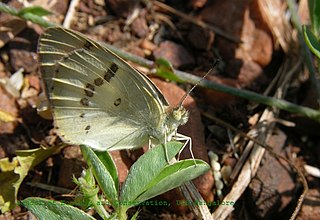
Colotis, called orange tips or Arabs, is a genus of butterflies of the subfamily Pierinae found mainly in Africa and south-western Asia. The larvae of all Colotis species specialize on plants in the family Capparaceae.

Belenois gidica, the African veined white or pointed caper, is a butterfly in the family Pieridae. It is found in the Afrotropical realm.
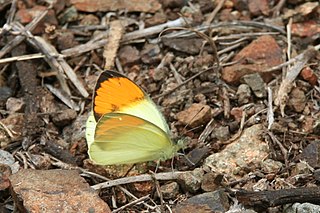
Colotis auxo, the yellow orange tip or sulphur orange tip, is a butterfly of the family Pieridae. The species was first described by Hippolyte Lucas in 1852. It is found in southern Africa and is named after the Keiskamma River.

Colotis euippe is a butterfly of the family Pieridae that is found in the Afrotropical realm.

Colotis evagore, the desert orange tip, small orange tip, or tiny orange tip, is a butterfly of the family Pieridae. It is found in the dry parts of tropical Africa, northern Africa, southern Spain and southwest Arabia.

Axiocerses amanga, the bush scarlet, is a butterfly of the family Lycaenidae. It is found in Sub-Saharan Africa.
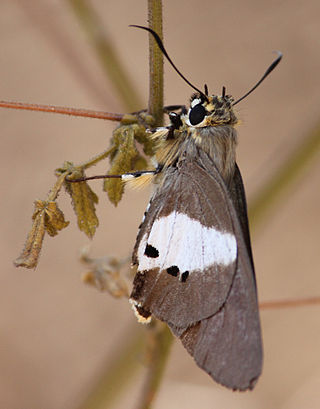
Coeliades pisistratus, the two-pip policeman, is a butterfly of the family Hesperiidae that occurs commonly in much of sub-Saharan Africa.

Colotis vesta, the veined tip, veined orange or veined golden Arab, is a butterfly of the family Pieridae. It is found in the Afrotropical realm.

Colotis regina, the queen purple tip, regal purple tip, or large violet tip, is a butterfly of the family Pieridae. It is found in the Afrotropical realm.

Colotis evenina, the common orange tip, is a butterfly of the family Pieridae. It is found in the Afrotropical realm.

Colotis antevippe, the red tip, is a butterfly of the family Pieridae. It is found in the Afrotropical realm.
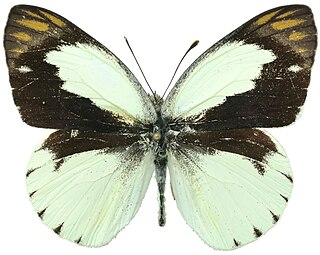
Colotis eris, the banded gold tip or black-barred gold tip, is a butterfly of the family Pieridae. It is found in the Afrotropical realm.

Colotis agoye, the speckled sulphur tip, is a butterfly of the family Pieridae. It is found in the Afrotropical realm.
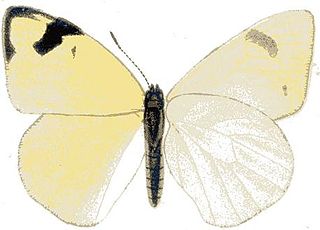
Colotis subfasciatus, the lemon tip or lemon traveller, is a butterfly of the family Pieridae. It is found in the Afrotropical realm. The habitat consists of savannah and Brachystegia woodland.

Pinacopteryx is a monotypic genus of pierid butterflies found in Africa containing Pinacopteryx eriphia, the zebra white.

Nepheronia buquetii, the plain vagrant, Buquet's vagrant, or green-eyed monster, is a butterfly of the family Pieridae. It is found throughout Africa.

Appias epaphia, the diverse white or African albatross, is a butterfly of the family Pieridae. It is found in Africa, south of the Sahara. The habitat consists of forests and heavy woodland.
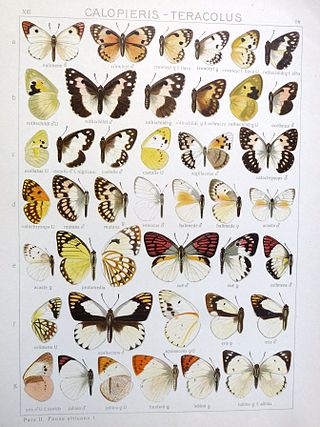
Colotis halimede, the yellow patch tip or yellow patch white, is a butterfly in the family Pieridae. It is found in Senegal, Mali, Nigeria, Niger, Sudan, Uganda, Ethiopia, Djibouti, Arabia, Somalia, Kenya, Tanzania and North Africa. The habitat consists of dry savanna.
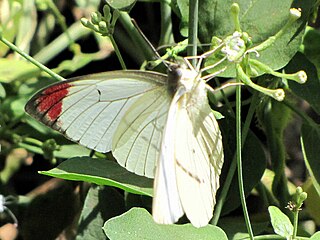
Colotis hetaera, the eastern purple tip, is a butterfly in the family Pieridae. It is found in Senegal, Mali, Nigeria, Niger, Sudan, Uganda, Ethiopia, Djibouti, Arabia, Somalia, Kenya, Tanzania and North Africa. The habitat consists of savannah, but penetrating the open parts of evergreen forests.






















